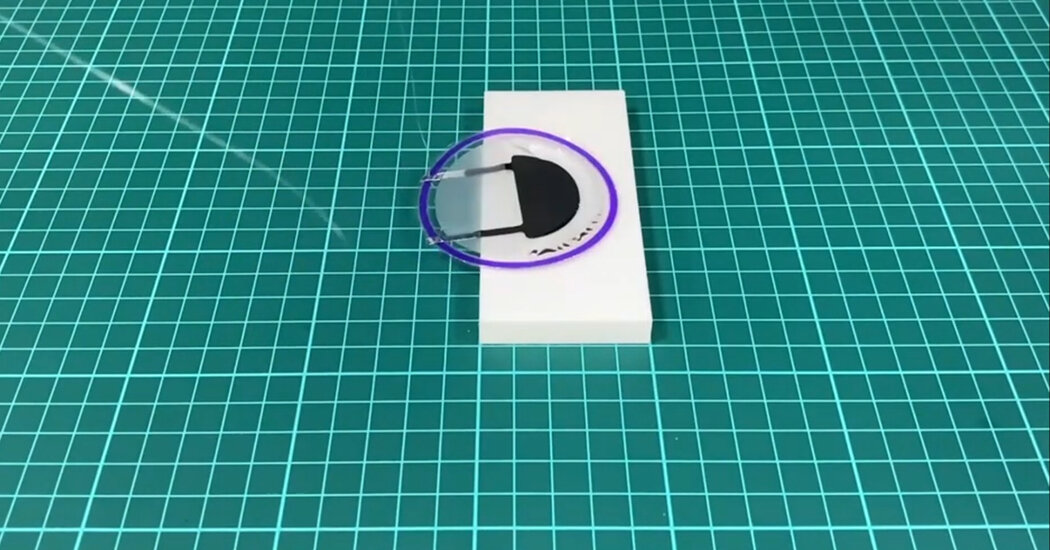
If a pancake could dream, it might long for legs so it could jump off your breakfast plate in pursuit of a better, unchewed life.
But legs, it turns out, are not necessary for something as flat as a flapjack to hop around. A group of scientists has designed a tortilla-shaped robot that can jump several times per second and higher than seven times its body height of half a centimeter. They report that the robot, which is the size of a squished tennis ball and weighs about the same as a paper clip, nimbly performs these feats without any semblance of feet. Their research was published on Tuesday in the journal Nature Communications.
Shuguang Li, a roboticist at Harvard who was not involved with the research, called the new robot “a clever idea” and “an important contribution to the soft robotics field.”
Many terrestrial robots, meaning ones at home on the ground rather than in air or water, move by rolling or walking. But the ability to jump can help a terrestrial robot traverse new spaces and navigate rough terrain; sometimes it’s more efficient for a robot to jump over an obstacle than to go around it, Rui Chen, a researcher at Chongqing University in China and an author of the paper, wrote in an email.
Although jumping can offer some robots a competitive edge, engineering that ability has been a challenge for robotics researchers. Some soft robots that store energy can perform a single, impressive jump very infrequently. Some lightweight soft robots that do not store energy can hop about very frequently but cannot jump high or far enough to successfully cross an obstacle like a curb.
The ideal jumping robot would be able to frequently jump high and far. But “these two pursuits are contradictory,” Dr. Chen said. Jumping higher or farther requires more energy, and jumping more frequently requires that energy to be accumulated and released over a shorter period of time — a tall task for a tiny robot.
For inspiration, the researchers looked to gall midge larvae, maggots that miraculously hurl themselves across distances 30 times as long as their loglike bodies, which are one-tenth of an inch long. “Most creatures need feet to jump,” Dr. Chen said, adding that the larvae “can leap by the bending of their bodies.” The maggot squishes itself into the shape of a ring — sticking its head to its rear with special sticky hairs — and squeezes fluid toward one end of its body, making it rigid. The accumulation of fluid builds up pressure, and releasing the pressure sends the maggot soaring.
The robot’s disklike body does not resemble that of a gall midge larva, but it jumps like one. Its body is made of two plastic pouches printed with electrodes; the front pouch is filled with liquid and the rear is filled with the same volume of air. The robot uses static electricity to drive the flow of liquid to deform parts of its body, which causes the body to bend and generate force with the ground, resulting in a jump. And the air pouch mimics the function of an animal’s tail, helping the robot maintain a stable position while jumping and landing.
This design allows the robot to jump 7.68 times its body height and have a continuous jumping speed of six body lengths per second — a speed that Dr. Li called “very impressive.”
So the robot could jump rapidly and continuously. But could it cross obstacles? To find out, the researchers put the tiny robot through numerous tests perhaps as deserving of a inspirational movie montage as Sylvester Stallone’s training in “Rocky.”
The robot had to cross various gravel mounds, slopes and wires. It had to jump across a round step five millimeters tall and traverse an empty ring eight millimeters tall — monumental barriers for a four-millimeter-tall robot with a body like a pancake. The amateur acrobat passed all of these tests easily, if not gracefully.
The robot can also change directions on its own, around 138 degrees per second — the fastest turning speed of any soft jumping robot, Dr. Chen said. Much like a car, the robot can steer itself by continuously turning, according to Wenqi Hu, a senior research scientist at the Max Planck Institute in Germany who was not involved with the research.
The robot relies on external power that is fed through electrical wires. The researchers would like to make the robot wireless in future iterations, but it will be a challenge to keep the robot tiny and lightweight, Dr. Chen said.
“I wonder if adding an onboard power source would be a challenge for this tiny soft jumper,” Dr. Li said.
The researchers propose integrating sensors into the tiny robot to allow it to detect environmental conditions, such as pollutants in buildings. Dr. Li suggested that the robot could eventually inspect hard-to-reach areas of large industrial machines or, if equipped with a small camera, be used on search-and-rescue missions for trapped people or animals, as it can travel through small spaces in disaster areas. And, he added, the robot is tiny and cheap. “It would probably cost only a few dollars to build one,” Dr. Li said.
Although the robot is currently confined to Earth, Dr. Hu suggested it might be right at home exploring another planet. “This type of task requires a simple but robust miniature robot design” that is lightweight enough to be carried to new worlds, Dr. Hu said, adding that the materials needed to build this robot would need to survive and function in extraterrestrial environments.
If this is true, the researchers’ robot might jump over dusty rocks and craters on the moon or Mars, going where no pancake has gone before.



